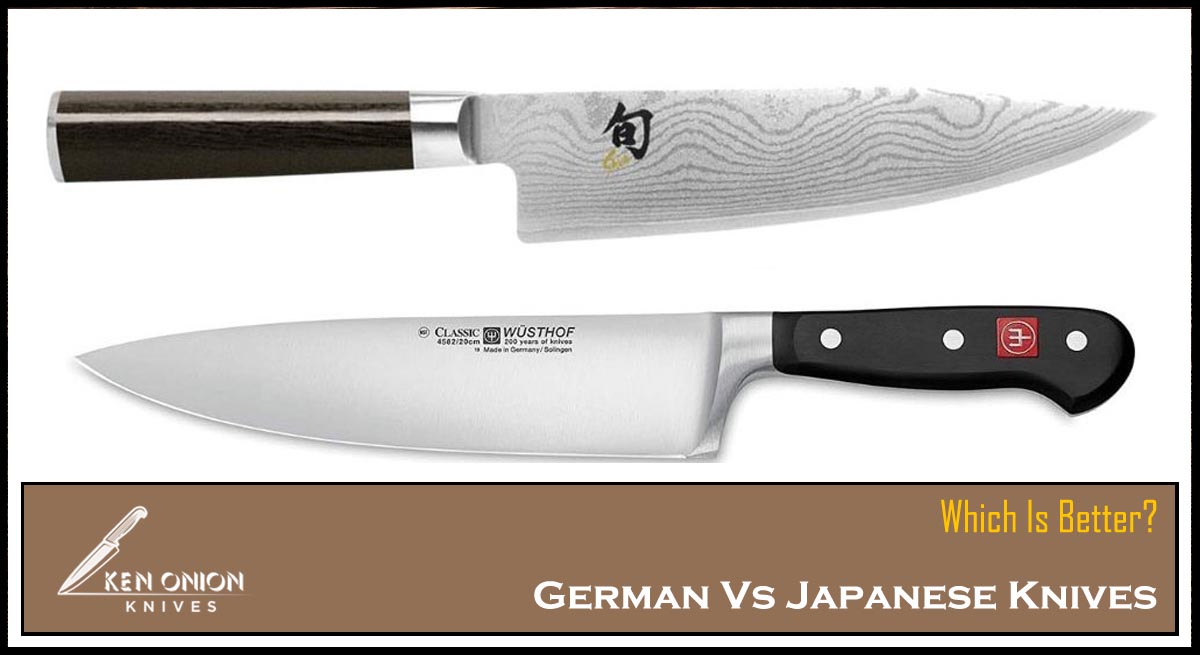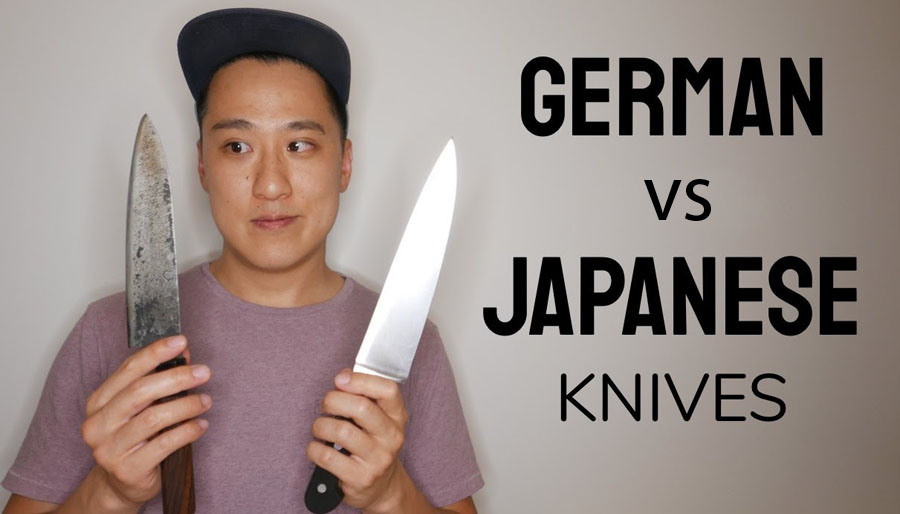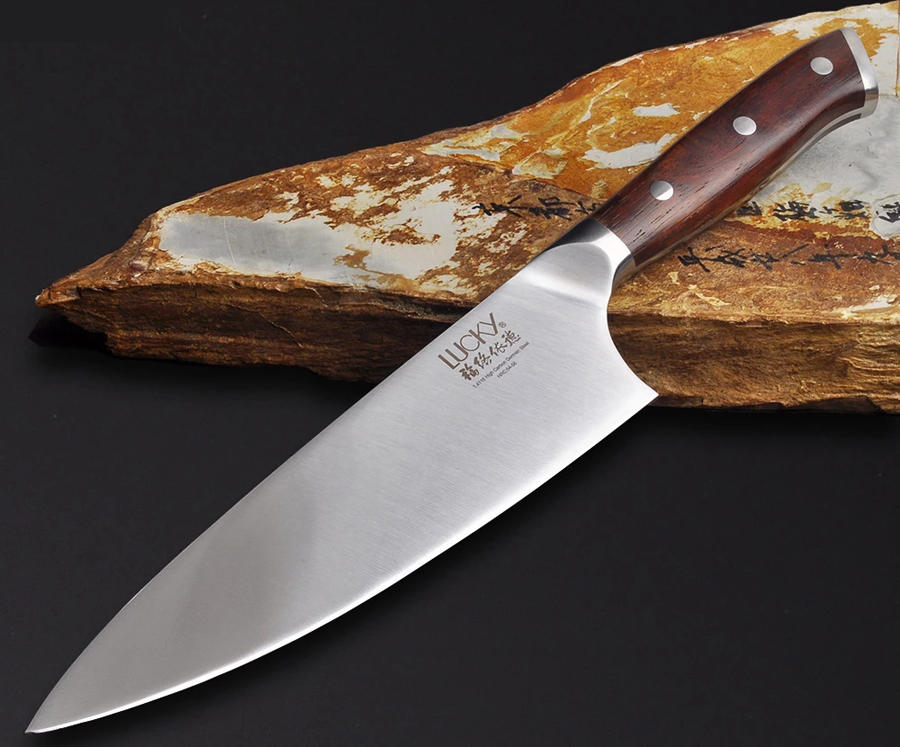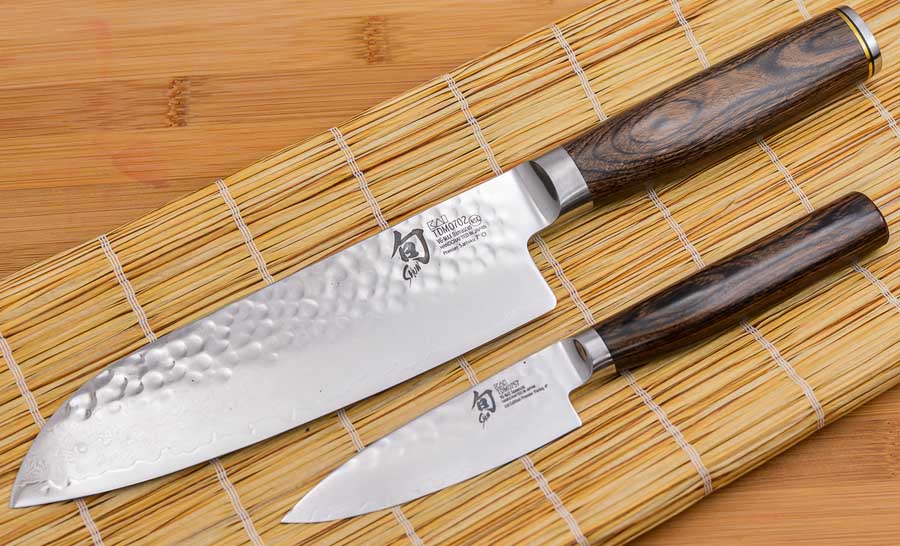German Vs Japanese Knives – Which Is Better?
There are a lot of debates when it comes to German vs Japanese knives. Which one is the best? Well, that really depends on your specific needs and preferences.
Both knife-making traditions have evolved over centuries, and produce some of the finest blades in the world.
So how do you decide which style of knife is right for you? In this blog post, we’ll take a look at the history and craftsmanship of German and Japanese knives, and help you decide which one is best for your needs.
What are German knives?
German knives are typically made with softer steel than their Japanese counterparts. This means they’re easier to sharpen, but not as durable. German knives also tend to be heavier and have more robust construction.
What are German knives used for?
The most common type of German knife is the chef’s knife. These knives are designed for chopping, slicing, and dicing. They usually have a curved blade that’s between 8 and 10 inches long.
Most products of German knives.
Some other common types of German knives include
Paring knife: a smaller knife ideal for peeling and cutting fruit.
Bread knife: with a serrated blade that’s great for slicing bread.
Santoku knife: a versatile all-purpose kitchen knife.
Features of German knives.
Some of the most notable features of German knives include:
Heavier construction.
German knives are often made with thicker blades and sturdier handles. This makes them ideal for heavy-duty tasks like chopping through tough meats and vegetables.
Easy to sharpen
The softer steel used in German knives is relatively easy to sharpen, even for beginners.
Good value
German knives are typically more affordable than their Japanese counterparts.
Angle.
German knives typically have a thicker blade angle, ranging from 15 to 20 degrees. This gives the knife more durability and helps it keep its edge for longer.
Knuckle clearance.
The curve in German knives helps them fit comfortably in your hand. They also provide plenty of knuckle clearance when you’re chopping ingredients, so you won’t accidentally hit your knuckles on the cutting board or countertop.
Balance.
If you like using heavy-duty kitchen tools, then German knives are definitely for you! These blades tend to be heavier than Japanese ones, which makes them the perfect choice if you do most of your cooking over a flame (such as on a stovetop) rather than an oven or microwave.
Shape.
German knives have a more pronounced curve near the tip, which is perfect for rocking your knife back and forth to do delicate tasks like slicing meat.
Weight.
German knives are known for their heftiness. A Wusthof eight-inch chef’s knife, which weighs in at 9 ounces and has an edge shaped like a razor blade to mince garlic or chop vegetables easily with less effort than other types of Kitchen Knives
A shorter sharper blade can be easier on your hands when you’re cooking up some serious storm!
Thickness.
Some people might find the blade of this knife is on the thicker side, which makes it feel a bit more substantial in your hand.
Steel.
German knives are typically made from softer steel which makes them easier to sharpen. However, this also means they’re more prone to rusting if they’re not properly cared for.
What are Japanese knives?
Japanese knives are typically made with harder steel than their German counterparts, which means they’re sharper but can be more difficult to sharpen or repair than a German knife.
What are Japanese knives used for?
Japanese blades are often thinner and lighter than German ones, making them ideal for slicing and chopping delicate ingredients like herbs and veggies.
The most common type of Japanese knife is the sushi knife, which is designed for slicing fish.
They also tend to have a straighter blade that’s between 7 and 10 inches long.
Most products of Japanese knives.
Other popular Japanese knife styles include:
Santoku knife: a versatile all-purpose kitchen knife.
Nakiri knife: a vegetable knife with a straight blade.
Yanagiba knife: a sushi knife with a curved blade.
Features of Japanese knives.
Some of the most notable features of Japanese knives include:
Harder steel.
Japanese knives are often made with harder steel, which makes them sharper but also more difficult to sharpen or repair if they’re damaged.
Thinner blades.
The thinner blades on Japanese knives make them ideal for slicing and chopping delicate ingredients.
Straighter blade.
As opposed to the curved blade of a German knife, Japanese knives typically have a straighter blade that’s between 7 and 10 inches long. This helps the knife glide smoothly through food without catching or tearing.
Single-beveled edge.
Most Japanese knives have a single-beveled edge, which means they’re only sharpened on one side. This is the traditional way of sharpening Japanese knives, and it’s said to help food slide off the blade more easily.
The shape of a Japanese knife is typically optimized for slicing and chopping, as opposed to German knives which are better suited for heavy-duty tasks like chopping through tough meats and vegetables. So if you’re looking for a versatile kitchen tool that can handle a wide range of cooking tasks with ease, then a Japanese knife might be right for you! And if you’re interested in learning more about the different types of knives out there, then be sure to explore our comprehensive guide on kitchen knives.
Angle.
Most Japanese knives have a blade angle of between 10 and 15 degrees, which helps the knife glide smoothly through food without catching or tearing.
Weight.
Japanese knives are often lighter than German knives, which makes them easier to handle for tasks that require more delicate slicing and chopping.
Steel.
Japanese knives are typically made from the harder steel, which makes them sharper but also more difficult to sharpen or repair if they’re damaged.
Shape.
The shape of a Japanese knife is typically optimized for slicing and chopping, as opposed to German knives which are better suited for heavy-duty tasks like chopping through tough meats and vegetables.
Handle.
Japanese knife handles are often made from wood or plastic, and they’re usually shorter than German knife handles. This makes them more comfortable to hold for people with small hands.
Thickness.
Thinner and often bolster-free, these bread have a higher proportion of flour to water than traditional white or whole wheat loaves. They’re best for people with sensitive teeth because they don’t contain any cane sugar which could irritate your gums if you eat too many pieces at one time!
German Vs Japanese Knives – The difference?
Usage.
German knives are typically more heavy-duty and versatile than Japanese knives, which are usually optimized for slicing and chopping delicate ingredients.
Therefore, if you’re looking for a kitchen knife that can handle a range of cooking tasks with ease, then a German knife is probably a better choice.
Blade shape.
In terms of blade shape, German knives tend to have broader blades with curved edges, while the blades of Japanese knives are straighter and thinner.
This makes them better suited for tasks like slicing and dicing fruits and vegetables.
Steel quality.
Another key difference between German and Japanese knives is the quality of their steel.
While both types of knives are typically made using high-quality stainless steel, German knives tend to be made with a higher grade of steel that is less likely to chip or break.
Handle Material.
When it comes to handling material, German knives are usually made with wood or plastic, while Japanese knives often have handles made from bone or horn.
Weight.
German knives are typically heavier than Japanese knives, which makes them better suited for tasks that require more brute force, such as chopping through tough meats and vegetables.
Price.
In terms of price, German knives tend to be more expensive than Japanese knives because they’re usually made with higher-quality materials.
However, both types of knives can be found at a variety of different price points depending on their features and quality.
So if you’re looking for a versatile and high-quality kitchen knife, then either type of knife could be a good choice for you!
Blade Angle.
One key difference between German and Japanese knives is the blade angle. Most Japanese knives have a blade angle of around 10-15 degrees, which allows them to glide smoothly through food without catching or tearing.
In contrast, German knives typically have a broader blade with a sharper angle, making them better suited for tasks that require more brute force and strength.
The Cutting Edge.
While both types of knives typically feature a double-beveled edge, most German knives have concave ground edges, while Japanese knives tend to have flat edges.
This makes them better suited for different tasks, with Japanese knives providing more precision and control when slicing or chopping, and German knives being better equipped for tasks that require more force.
Design.
Both types of knives typically have a curved or straight blade, the handles of Japanese knives are generally shorter than those of German knives, which makes them more comfortable to hold for people with smaller hands.
Furthermore, Japanese knives typically have thinner blades and no bolster, while German knives tend to be heavier and made with higher-quality materials like stainless steel.
Whether you’re looking for a versatile kitchen knife that can handle a range of cooking tasks with ease or prefer something lighter and more flexible that’s optimized for slicing and chopping delicate ingredients, there are many factors to consider when choosing. Ultimately, it all comes down to your individual needs and preferences when deciding
Hardness.
Finally, another major difference is their relative hardness. While both types of knives are typically made with high-quality stainless steel, German knives tend to be harder than Japanese knives because they need to be able to handle tougher chopping tasks without breaking or chipping.
Construction.
As far as construction goes, German knives are usually made with wood or plastic handles, while Japanese knives often have handles made from bone or horn. In terms of blade materials, German knives are typically made with higher-quality stainless steel, while Japanese knives often have thinner blades made from a softer metal.
Japanese knives vs German knives – The winner?
In the end, it all comes down to personal preference when deciding between German vs Japanese knives.
If you’re looking for a versatile kitchen knife that can handle a wide range of tasks with ease, then a German knife might be the right choice for you.
On the other hand, if you prefer something lighter and more flexible that’s optimized for slicing and chopping delicate ingredients, then a Japanese knife might be a better option.
German knives are typically heavier and made with higher-quality materials like stainless steel, making them better suited for tasks that require more brute force and strength.
In contrast, Japanese knives usually have thinner blades and no bolster, and their handles are generally shorter than those of German knives, which makes them more comfortable to hold for people with smaller hands.
With their thinner blades and sharper steel, they are perfect for slicing and chopping delicate ingredients with ease. And whether you’re looking for a versatile all-purpose knife or a specialized sushi knife, there’s sure to be a Japanese knife that’s right for you!
So if you’re looking to upgrade your kitchen toolkit, then be sure to check out the selection of high-quality Japanese knives at your local kitchenware store today.
While both German and Japanese knives are popular for their high quality and versatility, I would have to say that the winner is the Japanese knives.
FAQs about German Vs Japanese Knives.
Do chefs prefer German or Japanese knives?
It really depends on the chef. Some prefer German knives for their precision and durability, while others prefer Japanese knives for their sharpness and lighter weight. Ultimately, it comes down to personal preference.
Why are Japanese knives better than German?
There is no definitive answer to this question, as there are pros and cons to both of them. Some people prefer the sharpness and precision of Japanese knives, while others prefer the durability and sturdiness of German knives. Ultimately, it comes down to your individual preferences and needs when deciding between these two styles of knives.
How do Japanese knives differ from European knives?
The main difference between Japanese and European knives is the way they are sharpened. Japanese knives are typically sharpened at a much sharper angle, which makes them more precise but can also make them less durable. European knives, on the other hand, are typically sharpened at a less acute angle, resulting in a blade that is more durable but less precise. Ultimately, the choice between Japanese and European knives really depends on your individual preferences and needs as a chef or home cook.
What is the difference between German vs Japanese knives?
There are a number of differences between them. For starters, German knives tend to be heavier and sturdier, making them ideal for heavy-duty tasks like chopping and cutting. On the other hand, Japanese knives are typically sharper and more precise but can be less durable than German knives. Ultimately, which style of knife is best depends on your specific needs and preferences.
Are German knives worth it?
German knives are definitely worth the investment if you’re looking for a durable, precision knife. They can handle a lot of wear and tear and will stay sharp through repeated use. However, they may not be the best choice if you’re looking for a light, sharp knife that is easy to maneuver. Ultimately, it comes down to your individual needs and preferences when deciding between them.
So, are Japanese or German knives better?
There is no definitive answer to this question, as it really depends on your individual needs and preferences. Some people prefer the precision of Japanese knives, while others may prefer the durability of German knives. Ultimately, you should try out both styles of knives to see which one is best for you.
Why German cars are better than Japanese?
There is no definitive answer to this question, as there are pros and cons to both German and Japanese cars. Some people prefer the precision and performance of German cars, while others may prefer the affordability and reliability of Japanese cars. Ultimately, it comes down to your individual preferences when deciding between these two types of vehicles.
Conclusion
In the end, it is up to you to decide which knife set works best for your needs. Both of them have their own unique benefits that may appeal to you depending on what you are looking for in a kitchen knife set. Hopefully, this article has helped give you a better understanding of the differences between German vs Japanese knives so that you can make an informed decision about which type of knife set is right for you.
German knives are typically heavier and have a more pronounced curve to the blade. They excel at slicing meats but can be clumsy when performing other tasks.
Japanese knives are lighter and often have a flatter blade that is better for chopping vegetables or herbs. They are not as well-suited for cutting meat, but many chefs claim they can do everything a German knife can – and with greater precision. In the end, it comes down to personal preference and what you will be using your knife for most often.





